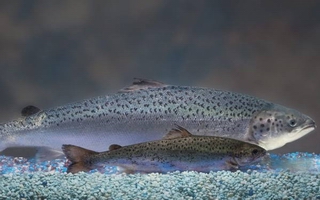 enetically modified Atlantic salmon that were cross-bred with wild brown trout had offspring that grew faster than the GM salmon, and outcompeted other fish for food, potentially posing a risk to wild fish species, a new study has found.
enetically modified Atlantic salmon that were cross-bred with wild brown trout had offspring that grew faster than the GM salmon, and outcompeted other fish for food, potentially posing a risk to wild fish species, a new study has found.The study, published Tuesday, is the first to show that GM fish that breed with other species have a competitive advantage over their parents, the researchers said.
The study, which was conducted at Newfoundland’s Memorial University, looked at the potential impact of GM fish on a closely related wild fish population.
The researchers found that the growth rates of wild salmon and GM salmon were dramatically lower when transgenic hybrids — GM fish crossed with wild trout — were present.
“Our results identify this new avenue for potential environmental impacts, and make it clear that extra vigilance might be required when producing GM species in areas where they could come into contact with closely related species,” said researcher Krista Oke, now a biology PhD student at McGill University. “It shows that there needs to be really stringent safeguards to ensure that GM fish are sterile and that they don’t escape.”
The study was published in the Proceedings of the Royal Society B.
Using hatchery and stream-like conditions, researchers raised GM Atlantic salmon, wild Atlantic salmon, wild brown trout and hybrids of GM salmon crossed with trout.
Brown trout is a species that sometimes breeds with salmon. While cross-breeding between salmon and trout occurs infrequently in the wild — at a rate of only about one per cent — previous studies have found that when farmed salmon escape from hatcheries or fish farms into the wild, the rate increases to as high as 41 per cent, the researchers said.
“That’s important because if GM salmon were present in the wild, it would probably be because they had escaped from aquaculture,” Oke said.
The researchers used GM salmon eggs and sperm, which had been engineered to grow quickly and exhibit risk-taking foraging behaviour, from the Prince Edward Island fish farm owned by AquaBounty Technologies Inc. It is the U.S. company seeking approval from the U.S. Food and Drug Administration for its fast-growing GM salmon.
AquaBounty has proposed producing its GM salmon eggs at its P.E.I. farm and then raising the fish to market size and processing them at a land-based facility in Panama.
In its draft environmental assessment of AquaBounty’s application, the FDA said the company’s plan to raise GM salmon posed no significant environmental risk because there was little chance the fish could escape and survive in the wild.
Oke said the security measures AquaBounty has in place in Panama — which the FDA says includes four separate physical containments for the fish, tank netting and chain-link fences — are good.
“Moving into the future, as production of GM animals and GM fish potentially becomes more common, it’s important that we continue to hold these technologies to such stringent regulations,” she said.





